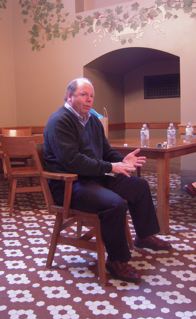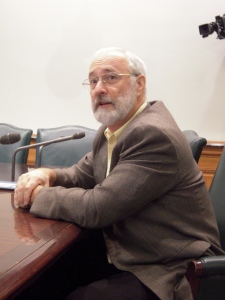
Joe Mansky
On Friday attendees were treated to a fascinating lunchtime talk by Ramsey County Elections Director Joe Mansky, who discussed Minnesota’s Coleman/Franken Senate election recount. Joe did yeoman’s work chatting with us in the beautifully restored but acoustically challenging Minnesota State Capitol’s Rathskeller. After admonishing us to pull our chairs closer, he recounted a story about when he did a lecture in West Virginia, and for the first time in his life watched a room fill from front to back – apparently Minnesotans always fill in starting from the back, leaving the front row seats for sheepish latecomers. The West Virginian woman that he talked to afterwards said that it came from the Baptist culture there. In church everyone always wanted to sit as close to God as possible, apparently quite different from Minnesota’s Lutheran roots.
Preparation for a possible recount began in June of 2008, when it became apparent that the Senate race could indeed be close enough to require a recount. Joe thinks this was the 3rd closest Senate race in American history, and challenged the roomful of librarians to help him find out for sure. He knew that something remarkable was going on when he got to work at 7:30 a.m. on November 5 to find several satellite television trucks parked out front, with a bunch of people milling around. The break room Joe had set aside for use by exhausted election judges involved in the recount was quickly taken over by the campaigns, which soon had televisions arranged, coffee set up, and pizza deliveries arriving. He suggested that the reasons for this massive amount of attention were the fact that this was a national race, Al Franken was a well-known figure, and the 60 vote majority filibuster margin in the Senate was still in play at this point.
Joe stressed that Franken won the election because Minnesota’s law instructs that in an election recount any ballots on which you can determine a voter’s intent should be included – if the recount was conducted under a different state’s guidelines the outcome would likely have been very different. This meant that some ballots that might have been missed by the optical scanning machines used for counting on election night were included in the recount totals if the voter’s intentions were clear and the ballots weren’t invalidated for some other reason. Apparently Democrats tend to pick up about 55% to Republicans’ 45% of the votes gained in recounts, which in a normal state race isn’t enough to make a difference in the result. But in an election with 2.9 million votes cast, Franken made up enough ground to swing Coleman’s election night lead to a final winning margin of 312 votes. In the end, Minnesota’s optical scanners (which allow the independent verification of ballots) were found to be 99.9% accurate, the absentee ballot counting process was found to be 99.5% accurate, and the Secretary of State’s voter database was found to be 99.9% accurate. There was palpable relief in the state once the race was finally decided after the Canvassing Board’s certification, the subsequent court case, and the MN Supreme Court’s decision on the appeal, but it was very interesting to relive parts of the process with one of the election officials involved. Much appreciated, Joe!
Jess Hopeman




 A shot of the LRL Staff Section Officers: Mary Camp (TX), Secretary; Shelley Day (UT), Chair-Elect; Elizabeth Lincoln (MN) Chair; Jackie Curro (MD), Immediate Past Chair.
A shot of the LRL Staff Section Officers: Mary Camp (TX), Secretary; Shelley Day (UT), Chair-Elect; Elizabeth Lincoln (MN) Chair; Jackie Curro (MD), Immediate Past Chair.

 Bob Horton, the Minnesota State Archivist, started off the session with a
Bob Horton, the Minnesota State Archivist, started off the session with a  Jim Greenwalt, the Senate IT Director in Minnesota, brought greetings from NCSL Staff Chair Nancy Cyr. Nancy is traveling a lot these days, while also trying to stay at home in Nebraska for an upcoming special session. Jim is a former NCSL Staff Chair. Thanks Jim!
Jim Greenwalt, the Senate IT Director in Minnesota, brought greetings from NCSL Staff Chair Nancy Cyr. Nancy is traveling a lot these days, while also trying to stay at home in Nebraska for an upcoming special session. Jim is a former NCSL Staff Chair. Thanks Jim!
 Shelley Day from Utah and Heather Morton from NCSL. Heather is very organized!
Shelley Day from Utah and Heather Morton from NCSL. Heather is very organized!
 It has been added to many of their most popular databases, including the
It has been added to many of their most popular databases, including the